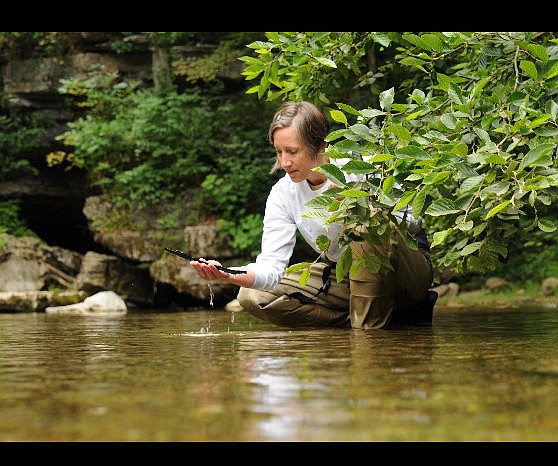They are rare, and only found in Marion County, Tenn. The species is known as the Sequatchie Caddisfly. The population, unknown at the time of this writing.
On the last day of July, U.S. Fish and Wildlife Service species biologist Stephanie Chance, from Cookeville, was first on the scene for an organized count of the creatures at Owen Spring, four miles north of Jasper, Tenn.
Chance and several biologists from the Tennessee Wildlife Resources Agency, Tennessee Department of Environment and Conservation, the University of Tennessee-Knoxville and the Kentucky Fish and Wildlife Service gathered for the count.
"We're going to try to do a population estimate to determine how many Caddisfly are in the spring," Chance said.
It's not a fly-by-fly operation.
"We just count the number that are in one-quarter meter, and then extrapolate the area that we'll have to estimate the number in our area," she said.
The Sequatchie Caddisfly is a recently found, rare species named in 1999. It lives as a larva in water, and the inch-long adults fly around in the fall and winter before dying.
Chance said the flies are also found in Martin Spring in the Battle Creek area of Marion County.
"It's a good 10 miles as the crow flies from this site," Chance said. "So do these two populations mix? Can the Caddisfly fly that far? We don't know."
As a species, Caddisflies are pretty much in every spring around the valley.
The difference between the Sequatchie Caddisfly and others is its banded legs, according to Chance. It's easy to see the little red bands around its front legs. (See online slide show).
The rare and common alike are found underwater in their larval stage this time of year. "They use wood and sand to make their caddis cases that they live in," Chance said.
But these little guys need a natural environment to survive, she said: running water with no beaver dams, no chemical spraying and no silt in the watershed.
The Sequatchie Caddisfly is scheduled to pupate in mid-to-late fall. Then they transform into their adult stage by crawling out of their case and beginning to fly.
As for the count, "we're actually going to come back in November and try to find some adults," Chance said. "It is satisfying seeing critters that are nowhere else in the world. It's just really neat."
Moment is a weekly column by the Times Free Press photo staff that explores the seldom-told stories of our region.

